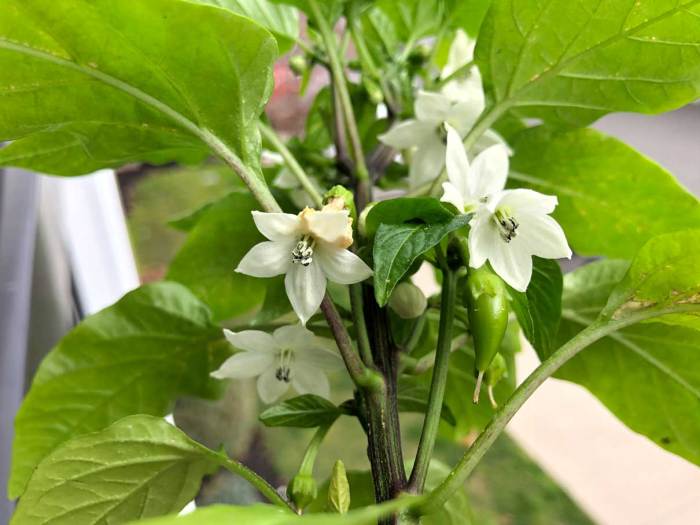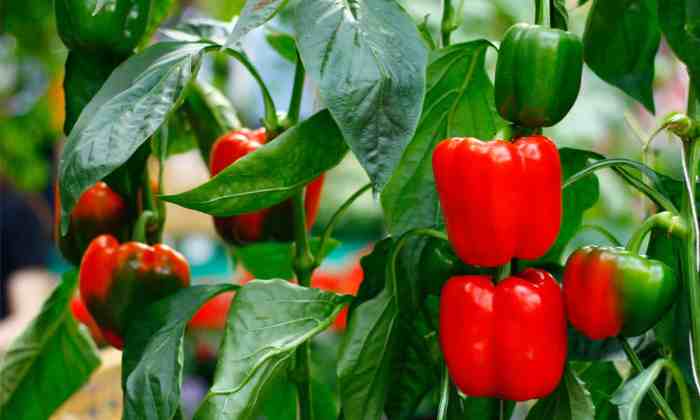Bell Pepper Plant Flower Morphology

Bell pepper plant flowers – Bell pepper flowers, while seemingly simple, are intricate structures crucial for the plant’s reproductive success. Understanding their morphology provides insights into the processes leading to the delicious peppers we enjoy. This section delves into the detailed anatomy of these fascinating blossoms and explores variations across different pepper types.
Bell Pepper Flower Structure and Function
The bell pepper flower, like other flowers, adheres to a basic floral plan. It possesses four main parts: sepals, petals, stamens, and pistil. The sepals, typically green and leaf-like, enclose the developing bud, protecting it from damage and harsh weather. As the flower matures, the sepals spread, revealing the vibrant petals. These petals, usually ranging in color from white to pale green or yellow depending on the variety, attract pollinators like bees and other insects.
The stamens, the male reproductive organs, consist of a filament topped by an anther. The anther produces pollen, the male gamete, which is transferred to the pistil for fertilization. The pistil, the female reproductive organ, is composed of the stigma (the receptive surface for pollen), the style (a slender stalk connecting the stigma to the ovary), and the ovary (containing the ovules, which develop into seeds after fertilization).
The entire process, from pollination to fertilization and fruit development, relies on the precise interplay of these floral components.
Comparison of Flower Morphology Across Bell Pepper Varieties
Different bell pepper varieties exhibit subtle yet significant variations in their flower morphology. These differences, while sometimes slight, can influence pollination efficiency and overall yield. The following table summarizes some key distinctions:
| Variety | Petal Color | Stamen Length (mm) – Approximate | Pistil Length (mm) – Approximate |
|---|---|---|---|
| Sweet Bell Pepper (e.g., California Wonder) | Creamy White to Pale Yellow-Green | 5-7 | 6-8 |
| Chili Pepper (e.g., Jalapeño) | Pale Green to Whitish | 4-6 | 5-7 |
| Banana Pepper | Light Greenish-Yellow | 5-6 | 6-7 |
| Poblano Pepper | Pale Green | 6-8 | 7-9 |
Note: Stamen and pistil lengths are approximate and can vary depending on environmental factors and specific cultivar.
Developmental Stages of a Bell Pepper Flower
The development of a bell pepper flower is a gradual process, marked by distinct changes in size, shape, and color. It begins as a tightly closed bud, protected by the sepals. The bud gradually increases in size, and the sepals begin to unfurl slightly. As the flower matures, the petals, initially tightly packed within the bud, begin to expand and separate, revealing their color.
This stage marks the transition to a fully developed flower, ready for pollination. The stamens and pistil become fully visible, with the anthers producing pollen and the stigma becoming receptive. After pollination and fertilization, the petals eventually wither and fall off, and the ovary begins to swell, eventually developing into the bell pepper fruit. The entire process, from bud to full bloom, usually takes several days to a week, depending on environmental conditions such as temperature and sunlight.
Bell Pepper Flower and Pest/Disease Issues

Protecting the delicate blossoms of your bell pepper plants is crucial for a bountiful harvest. These vibrant flowers are susceptible to a range of pests and diseases that can significantly impact fruit production. Understanding these threats and implementing effective control measures is key to ensuring a healthy and productive pepper plant. Ignoring these issues can lead to significantly reduced yields or even complete crop failure.
Common Pests and Diseases Affecting Bell Pepper Flowers, Bell pepper plant flowers
The health of bell pepper flowers is directly linked to the overall yield. Various pests and diseases can target these flowers, hindering pollination and fruit development. Early detection and prompt action are essential to minimize damage.
| Pest/Disease | Symptoms | Impact on Flower | Control Measures |
|---|---|---|---|
| Aphids | Small, soft-bodied insects clustered on flowers and leaves; leaves may curl or become distorted; sticky honeydew excretion. | Reduced pollination due to feeding on flower parts; stunted flower development; transmission of plant viruses. | Handpicking; insecticidal soap; introducing beneficial insects like ladybugs; using horticultural oil. |
| Spider Mites | Tiny mites that spin fine webs on leaves and flowers; stippling or discoloration of leaves and flowers; fine webbing visible. | Reduced pollination due to damage to flower parts; stunted flower growth; premature flower drop. | Regularly misting plants; using insecticidal soap or miticide; introducing predatory mites. |
| Whiteflies | Small, white, winged insects found on the undersides of leaves; leaves may yellow; sticky honeydew excretion. | Reduced pollination due to feeding on flower parts; stunted flower development; transmission of plant viruses. | Yellow sticky traps; insecticidal soap; introducing beneficial insects. |
| Blossom-End Rot | Dark, leathery spots on the blossom end of the fruit; often begins before fruit is fully developed; can affect flowers indirectly. | Indirectly impacts flower success by affecting fruit development; calcium deficiency often the underlying cause. | Ensure consistent soil moisture; apply calcium supplements to the soil; mulch to retain moisture. |
| Anthracnose | Small, sunken lesions on leaves, stems, and flowers; lesions may enlarge and coalesce; can lead to leaf and flower drop. | Reduced flower viability; premature flower drop; infection can spread to developing fruits. | Use disease-resistant varieties; remove infected plant material; apply fungicides. |
Preventative Measures and Integrated Pest Management
Proactive measures are far more effective than reactive treatments. Integrated pest management (IPM) is a holistic approach that combines various strategies to minimize pest and disease problems while minimizing environmental impact.Preventative measures include selecting disease-resistant varieties, ensuring proper spacing between plants for good air circulation, providing adequate sunlight and water, and maintaining soil fertility. Regular monitoring for early detection of pests and diseases is crucial.
Early detection allows for timely intervention, preventing widespread infestation or infection. IPM emphasizes using the least toxic methods first, such as handpicking pests, introducing beneficial insects, and using natural pest control methods like insecticidal soaps or horticultural oils. Chemical pesticides should be used only as a last resort and only after careful consideration of their impact on the environment and beneficial insects.
A healthy plant, properly cared for, is far less susceptible to pests and diseases.
Bell pepper plants, known for their vibrant flowers, require specific conditions for optimal growth. Understanding the principles of successful flowering is crucial for a bountiful harvest. For effective cultivation, consider the techniques outlined in this comprehensive guide on how to plant flowers in pots , adapting them to the unique needs of bell peppers. Proper potting and care significantly influence the flowering and fruiting stages of the bell pepper plant.
Bell Pepper Flower and Plant Breeding: Bell Pepper Plant Flowers

Understanding the intricacies of bell pepper flower biology is crucial for developing effective plant breeding programs. By manipulating key floral characteristics, breeders can significantly improve yield, fruit quality, and overall plant performance. This involves a deep understanding of pollination mechanisms, genetic control of flower development, and the interaction between the flower and its environment.
Selective Breeding Techniques for Bell Pepper Flower Improvement
Selective breeding leverages the natural variation within bell pepper populations to enhance desirable traits. This involves carefully selecting parent plants with superior characteristics and crossing them to produce offspring with improved traits. Several techniques are employed to achieve this, focusing on specific aspects of the flower. For instance, breeders might select for larger flowers to increase the potential for fruit set.
Larger flowers often contain more ovules, leading to larger fruits. Alternatively, focusing on increased pollen production can improve pollination efficiency, especially in varieties with self-incompatibility issues. A successful example is the development of bell pepper varieties with increased self-compatibility, eliminating the need for pollinators and improving fruit production in environments with limited insect activity. This involved identifying and selecting plants with higher self-pollination rates and then repeatedly crossing these plants over multiple generations.
The resulting varieties showed a significant increase in fruit set compared to their less self-compatible predecessors. Another approach involves selecting for flowers with improved stigma receptivity, ensuring successful fertilization even under less-than-ideal environmental conditions.
Hypothetical Breeding Program: Enhancing Pollination Efficiency in ‘Sweet Jewel’ Bell Peppers
Let’s consider a hypothetical breeding program aimed at improving the pollination efficiency of the ‘Sweet Jewel’ bell pepper variety. This variety, while producing high-quality fruit, suffers from relatively low fruit set due to inconsistent pollination. The program would follow these steps:
- Parent Plant Selection: Identify ‘Sweet Jewel’ plants exhibiting superior pollination characteristics. This might include plants with larger flowers, greater pollen production, or more vigorous pollen tube growth. These superior plants would serve as the initial parental lines.
- Controlled Crosses: Perform controlled crosses between the selected ‘Sweet Jewel’ plants. This involves carefully transferring pollen from the anthers of one selected plant to the stigma of another. Multiple crosses would be performed to generate a diverse population of offspring.
- Evaluation and Selection: Evaluate the offspring based on fruit set percentage and other relevant parameters, such as fruit size and quality. Plants exhibiting the highest fruit set would be selected for the next generation.
- Generational Advancement: Repeat steps 2 and 3 for multiple generations. This process of repeated selection and crossing progressively improves the pollination efficiency of the ‘Sweet Jewel’ variety. The process of selection should also focus on maintaining the desired fruit characteristics of the original ‘Sweet Jewel’ variety, preventing unwanted changes in fruit quality.
- Genotyping (Optional): Employ marker-assisted selection (MAS) to identify specific genes associated with improved pollination efficiency. This would allow for more precise selection of superior plants, accelerating the breeding process.
Through this multi-generational breeding program, we can expect to develop a new ‘Sweet Jewel’ variant with significantly enhanced pollination efficiency, leading to increased yield and improved fruit production. This hypothetical program mirrors actual breeding programs undertaken to improve various aspects of crop plants, demonstrating the power of selective breeding in addressing specific challenges.
FAQ
What is the best time of day to hand-pollinate bell peppers?
Early morning is generally best, as pollen is often most viable then.
Why are my bell pepper flowers dropping off without producing fruit?
This could be due to insufficient pollination, poor environmental conditions (temperature extremes, lack of water), or nutrient deficiencies.
How can I tell if my bell pepper flowers have been successfully pollinated?
The flower will usually wither and drop off, and the ovary will begin to swell, indicating fruit development.
What are some common signs of a nutrient deficiency affecting bell pepper flower production?
Yellowing leaves, stunted growth, and fewer or smaller flowers are common indicators.
